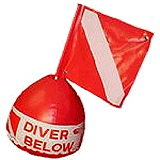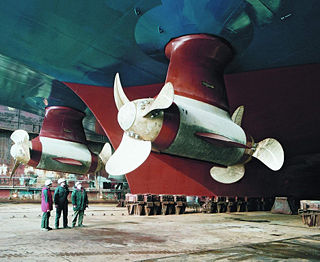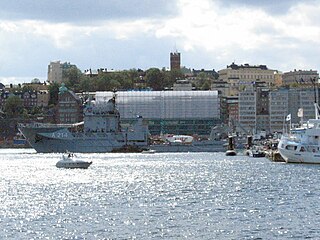
A surface marker buoy, SMB, dive float or simply a blob is a buoy used by scuba divers, at the end of a line from the diver, intended to indicate the diver's position to people at the surface while the diver is underwater. Two kinds are used; one (SMB) is towed for the whole dive, and indicates the position of the dive group throughout the dive, and the other, a delayed surface marker buoy, DSMB or decompression buoy, is deployed towards the end of the dive as a signal to the surface that the divers have started to ascend, and where they are going to surface. Both types can also function as a depth reference for controlling speed of ascent and accurately maintaining depth at decompression stops. Surface marker buoys are also used by freedivers in open water, to indicate the approximate position of the diver when submerged. They may also be used to support a catch bag or fish stringer by underwater hunters and collectors. A DSMB is considered by recreational scuba divers and service providers to be a highly important item of safety equipment, yet its use is not part of the entry level recreational diver training for all training agencies, and there are significant hazards associated with incompetent use.

A submersible is an underwater vehicle which needs to be transported and supported by a larger watercraft or platform. This distinguishes submersibles from submarines, which are self-supporting and capable of prolonged independent operation at sea.

A diver propulsion vehicle (DPV), also known as an underwater propulsion vehicle, sea scooter, underwater scooter, or swimmer delivery vehicle (SDV) by armed forces, is an item of diving equipment used by scuba divers to increase range underwater. Range is restricted by the amount of breathing gas that can be carried, the rate at which that breathing gas is consumed, and the battery power of the DPV. Time limits imposed on the diver by decompression requirements may also limit safe range in practice. DPVs have recreational, scientific and military applications.

A midget submarine is any submarine under 150 tons, typically operated by a crew of one or two but sometimes up to six or nine, with little or no on-board living accommodation. They normally work with mother ships, from which they are launched and recovered and which provide living accommodation for the crew and support staff.

An azimuth thruster is a configuration of marine propellers placed in pods that can be rotated to any horizontal angle (azimuth), making a rudder redundant. These give ships better maneuverability than a fixed propeller and rudder system.

A diving support vessel is a ship that is used as a floating base for professional diving projects. Basic requirements are the ability to keep station accurately and reliably throughout a diving operation, often in close proximity to drilling or production platforms, for positioning to degrade slowly enough in deteriorating conditions to recover divers without excessive risk, and to carry the necessary support equipment for the mode of diving to be used.

An atmospheric diving suit (ADS) is a small one-person articulated submersible which resembles a suit of armour, with elaborate pressure joints to allow articulation while maintaining an internal pressure of one atmosphere. An ADS can enable diving at depths of up to 700 metres (2,300 ft) for many hours by eliminating the majority of significant physiological dangers associated with deep diving. The occupant of an ADS does not need to decompress, and there is no need for special breathing gas mixtures, so there is little danger of decompression sickness or nitrogen narcosis when the ADS is functioning properly. An ADS can permit less skilled swimmers to complete deep dives, albeit at the expense of dexterity.
Submarine Products Ltd (1959−1990) was a diving gear manufacturer, with a factory in Hexham in Northumberland, England. It was founded in 1959 by Lieutenant-Commander Hugh Oswell.
An elektroboot was a submarine designed to operate entirely submerged, rather than as submersibles that could submerge as a temporary means to escape detection or launch an attack.
Defenses against swimmer incursions are security methods developed to protect watercraft, ports and installations, and other sensitive resources in or near vulnerable waterways from potential threats or intrusions by swimmers or scuba divers.

A radio-controlled submarine is a scale model of a submarine that can be steered via radio control. The most common form are those operated by hobbyists. These can range from inexpensive toys to complex projects involving sophisticated electronics. Oceanographers and military units also operate radio-controlled submarines.
The history of the submarine goes back to antiquity. Humanity has employed a variety of methods to travel underwater for exploration, recreation, research and significantly, warfare. While early attempts, such as those by Alexander the Great, were rudimentary, the advent of new propulsion systems, fuels, and sonar, propelled an increase in submarine technology. The introduction of the diesel engine, then the nuclear submarine, saw great expansion in submarine use – and specifically military use – during World War I, World War II, and the Cold War. The Second World War use of the U-Boat by the Kriegsmarine against the Royal Navy and commercial shipping, and the Cold War's use of submarines by the United States and Russia, helped solidify the submarine's place in popular culture. The latter conflicts also saw an increasing role for the military submarine as a tool of subterfuge, hidden warfare, and nuclear deterrent. The military use of submarines continues to this day, predominantly by North Korea, China, the United States and Russia.

The Davis Submerged Escape Apparatus, was an early type of oxygen rebreather invented in 1910 by Sir Robert Davis, head of Siebe Gorman and Co. Ltd., inspired by the earlier Fleuss system, and adopted by the Royal Navy after further development by Davis in 1927. While intended primarily as an emergency escape apparatus for submarine crews, it was soon also used for diving, being a handy shallow water diving apparatus with a thirty-minute endurance, and as an industrial breathing set.
Underwater logging is the process of logging trees from underwater forests. When artificial reservoirs and dams are built, large areas of forest are often inundated; although the trees die, the wood is often preserved. The trees can then be felled using special underwater machinery and floated up to the surface. One such machine is the sawfish harvester. There is an ongoing debate to determine whether or not underwater logging is a sustainable practice and if it is more environmentally sustainable than traditional logging.

The Welfreighter was a Second World War British midget submarine developed by the Special Operations Executive (SOE) for the purpose of landing and supplying agents behind enemy lines. It only saw action once and was not particularly successful.

URF is the Royal Swedish Navy’s Submarine Rescue Vessel.
CosMoS CE2F were a series of swimmer delivery vehicles (SDV) built by M/s Cos.Mo.S Spa. which was based in Livorno, Italy.

The following outline is provided as an overview of and topical guide to underwater diving:

The following index is provided as an overview of and topical guide to underwater diving:
A variable-buoyancy pressure vessel system is a type of rigid buoyancy control device for diving systems that retains a constant volume and varies its density by changing the weight (mass) of the contents, either by moving the ambient fluid into and out of a rigid pressure vessel, or by moving a stored liquid between internal and external variable-volume containers. A pressure vessel is used to withstand the hydrostatic pressure of the underwater environment. A variable-buoyancy pressure vessel can have an internal pressure greater or less than ambient pressure, and the pressure difference can vary from positive to negative within the operational depth range, or remain either positive or negative throughout the pressure range, depending on design choices.












